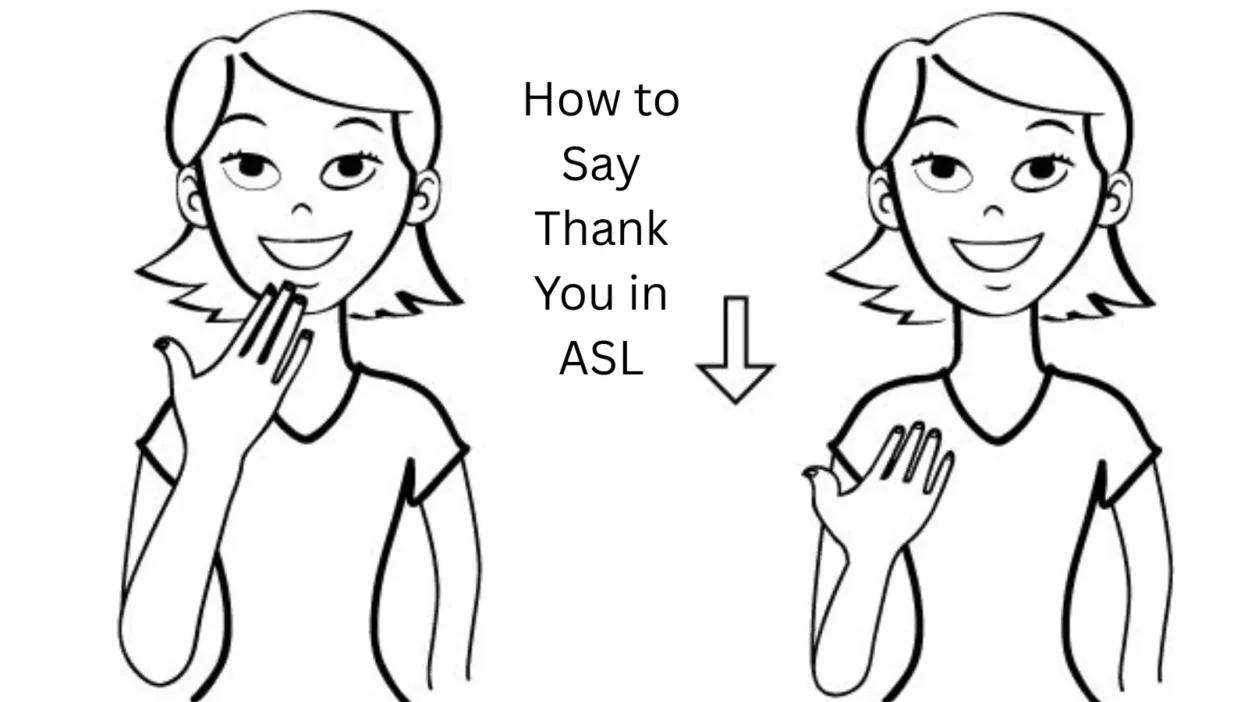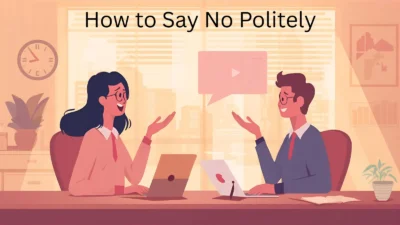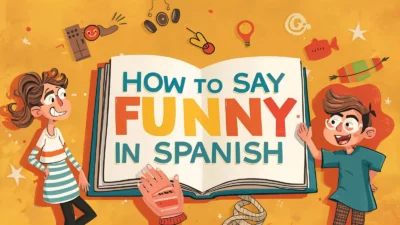🙏 How to Say Thank You in ASL is a great first step for anyone learning American Sign Language.
The gesture is simple — a flat hand starting at the chin and moving forward — but it carries a powerful message of gratitude.
Whether you’re interacting with Deaf individuals or just want to be more inclusive in your communication, learning this sign shows respect and kindness in a meaningful way.
Thank You in ASL
✋ 15 Ways to Say Thank You in ASL
| 🤟 ASL Expression | 👐 How to Sign | 💬 Meaning | 🎯 Context |
|---|---|---|---|
| Thank You | Flat hand from chin outward | Thank you | Standard polite expression |
| Thanks a Lot | Repeat “Thank You” with more emphasis | Thanks a lot | Stronger gratitude |
| Thank You Very Much | “Thank You” + sign for “Very” | Thank you very much | Formal, warm |
| Many Thanks | Both hands signing “Thank You” repeatedly | Many thanks | Extra emphasis |
| Big Thanks | “Thank You” + big movement outward | Big thanks | Informal, cheerful |
| Thank You So Much | Exaggerated “Thank You” + “Much” | Thank you so much | Heartfelt |
| Thanks Friend | “Thank You” + sign for “Friend” | Thanks, friend | Casual, personal |
| Thanks Everyone | “Thank You” sweeping motion to group | Thanks everyone | Group setting |
| Thanks Teacher | “Thank You” + sign for “Teacher” | Thank you teacher | Classroom/formal |
| Thanks Family | “Thank You” + sign for “Family” | Thank you family | Warm, personal |
| Deep Thanks | “Thank You” done slowly with two hands | Deep gratitude | Emotional context |
| Appreciate | Sign for “Appreciate” (two flat hands on chest moving forward) | I appreciate it | Formal, heartfelt |
| Grateful | One hand brushing upward on chest | Grateful | More emotional tone |
| Forever Thankful | “Thank You” + sign for “Always” | Forever thankful | Emotional, long-lasting |
| Bless You/Thanks | “Thank You” + open-hand blessing gesture | Bless you / Thanks | Religious/spiritual |
Let’s explore 15 authentic ways to say thank you in ASL, complete with examples and insights into their usage and cultural roots.
1. Thank You
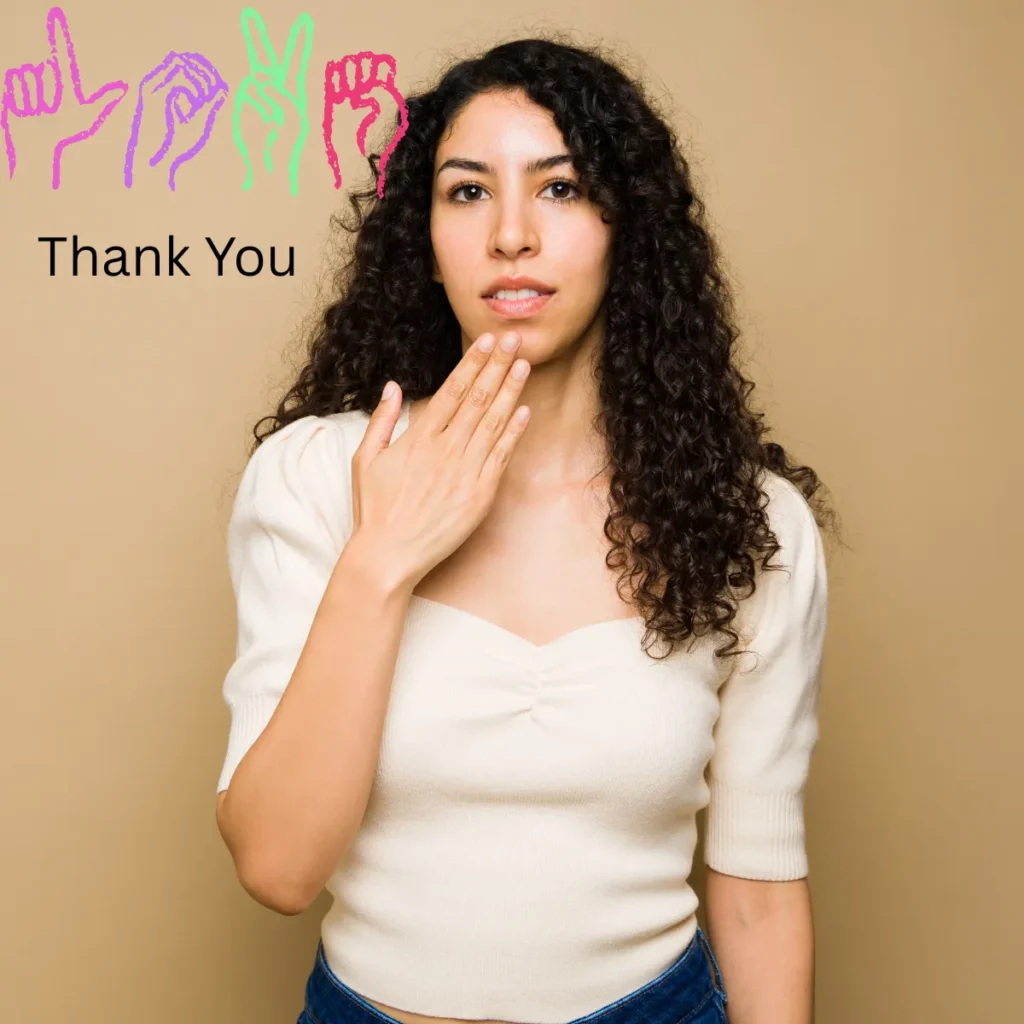
How to Sign:
Place the fingertips of one hand at your chin and move it outward, like blowing a kiss.
Example:
👤 User A: (Signs: THANK YOU)
👤 User B: (Smiles and nods)
Origin/Context:
This is the standard and most widely taught sign for “thank you” in ASL. It’s polite, clear, and universally understood in Deaf communities.
2. Thanks
How to Sign:
Same as “thank you,” but used more casually—often quicker in motion or with a smile.
Example:
👤 User A: (Signs THANKS with a casual wave)
👤 User B: (Signs: YOU’RE WELCOME)
Context:
Used informally, often between friends or in casual conversations.
3. Thank You Very Much
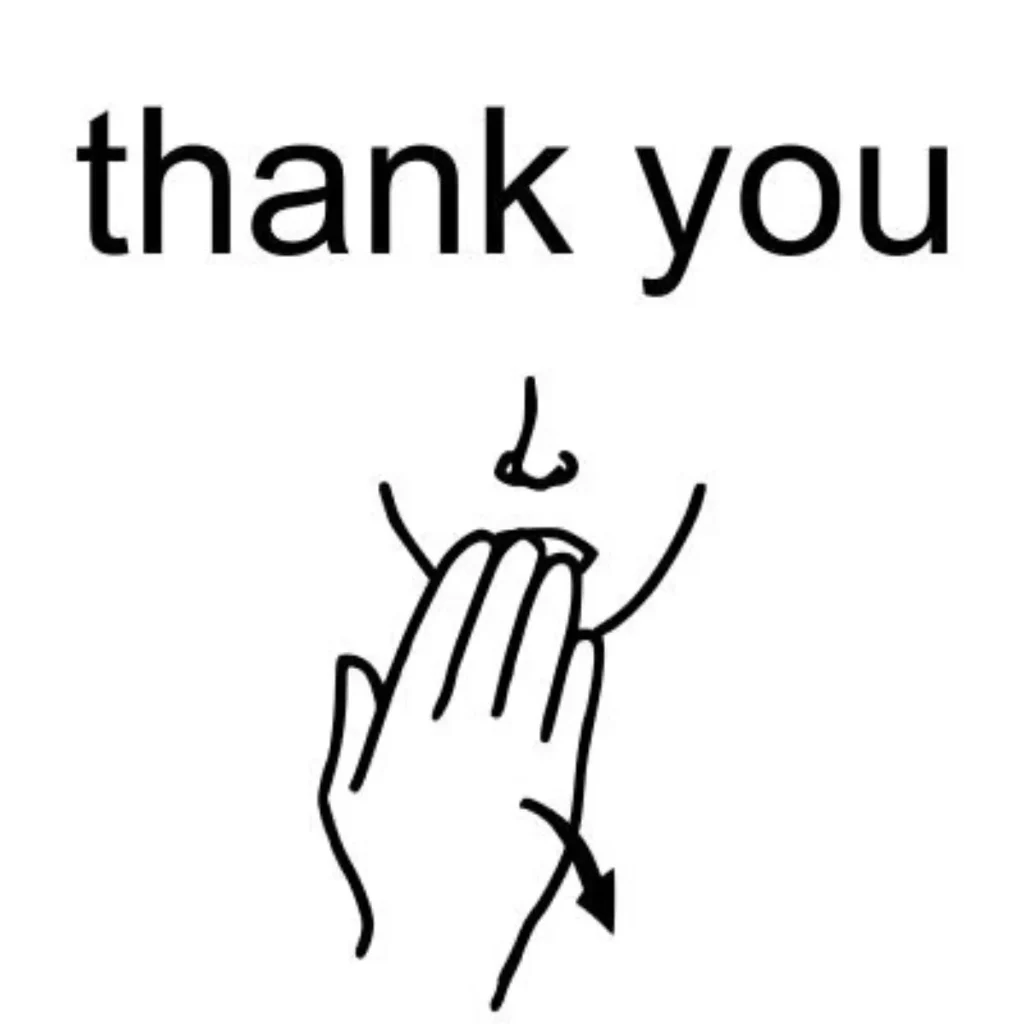
How to Sign:
Sign “thank you” and then add emphasis with “VERY” and “MUCH” (flat hands moving outward, showing intensity).
Example:
👤 User A: (Signs: THANK YOU VERY MUCH)
👤 User B: (Signs: I’M HAPPY TO HELP)
Context:
Used when you want to express deep gratitude or sincere appreciation.
4. Thanks a Lot
How to Sign:
Combine “THANK YOU” with facial expressions that show exaggeration (wide smile, raised eyebrows).
Example:
👤 User A: (Signs THANK YOU + exaggerated expression)
👤 User B: (Nods and signs: NO PROBLEM)
Context:
Similar to “thank you very much” but more animated or playful.
5. Much Obliged (Formal Sign Equivalent)
How to Sign:
Use signs for “THANK YOU” and “HONOR” (flat hand circles over chest) together.
Example:
👤 User A: (Signs: THANK YOU + HONORED)
👤 User B: (Signs: MY PLEASURE)
Origin/Context:
Used in formal or respectful settings, like speaking to elders or teachers.
6. Appreciate
How to Sign:
Place your dominant hand on your chin, then make a circular motion out and down with both hands open.
Example:
👤 User A: (Signs: I APPRECIATE YOUR HELP)
👤 User B: (Signs: ANYTIME)
Context:
“Appreciate” is often used to show heartfelt or more thoughtful gratitude.
7. Grateful / Gratitude
How to Sign:
Use both hands to sign “THANK YOU” at the same time, with serious or thankful facial expression.
Example:
👤 User A: (Signs: I’M GRATEFUL FOR YOU)
👤 User B: (Signs: I FEEL THE SAME)
Context:
A deeper, more emotional expression than a casual thank you.
8. Bless You / Feeling Blessed
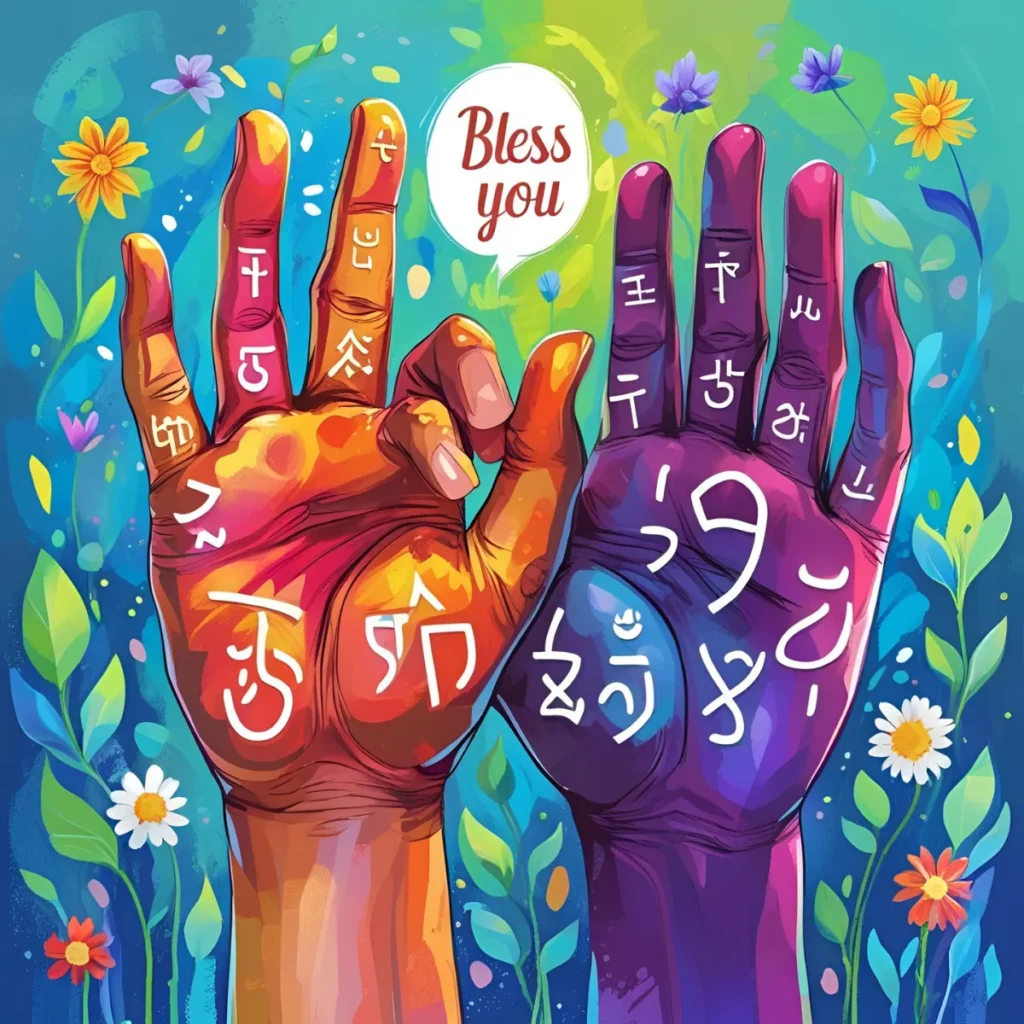
How to Sign:
Combine “THANK YOU” with the sign for “BLESS” (hands moving from mouth down to chest in a soft wave).
Example:
👤 User A: (Signs: THANK YOU + BLESS YOU)
👤 User B: (Smiles and signs: THANK YOU TOO)
Context:
Common in spiritual or religious contexts, or among those expressing heartfelt blessings.
9. Cheers / Thanks (British/Informal)
How to Sign:
Use “THANK YOU” with a slight head nod and informal smile.
Example:
👤 User A: (Signs: THANK YOU casually with head nod)
👤 User B: (Signs: YOU GOT IT)
Context:
Seen in Deaf communities influenced by British Sign Language (BSL) or in casual American settings.
10. Thumbs Up (Gesture-Based Thanks)
How to Sign:
A simple thumbs-up gesture paired with a smile.
Example:
👤 User A: (Gives thumbs up after receiving help)
👤 User B: (Nods and waves)
Context:
Common in casual or quick exchanges when formal ASL isn’t necessary.
11. Thanks + Smile + Head Nod
How to Sign:
Sign “THANK YOU” and add a big smile with a head nod.
Example:
👤 User A: (Signs THANK YOU with a warm smile)
👤 User B: (Signs: WELCOME)
Context:
Used to convey sincerity and friendliness.
12. Many Thanks
How to Sign:
Sign “THANK YOU” repeatedly (2–3 times) with slight variations in motion.
Example:
👤 User A: (Signs: THANK YOU x3)
👤 User B: (Signs: HAPPY TO HELP)
Context:
Used when someone has done a big favor or gone out of their way.
13. Clapping Hands (Visual Applause)
How to Sign:
Hold your hands up and twist them side to side (visual applause).
Example:
👤 User A: (Signs visual applause after a performance)
👤 User B: (Bows slightly)
Origin/Context:
Used instead of clapping in Deaf culture—shows appreciation and support.
14. Hand Over Heart
How to Sign:
Place your hand on your heart, then extend it outward like “thank you.”
Example:
👤 User A: (Signs: HEART + THANK YOU gesture)
👤 User B: (Touches chest in return)
Context:
Expresses emotional or personal gratitude, especially in meaningful moments.
15. YOU HELP — THANK YOU (Contextual Signing)
How to Sign:
Combine context signs like “YOU” + “HELP” + “THANK YOU.”
Example:
👤 User A: (Signs: YOU HELP ME — THANK YOU)
👤 User B: (Signs: HAPPY TO DO IT)
Context:
Shows specific appreciation and helps make your message clearer.
Conclusion:
Now that you’ve learned how to say thank you in ASL, you can express gratitude with confidence and inclusivity.
This simple sign goes a long way in showing respect and appreciation, especially when communicating with members of the Deaf community. Keep practicing and adding more signs to your vocabulary — every gesture counts!
